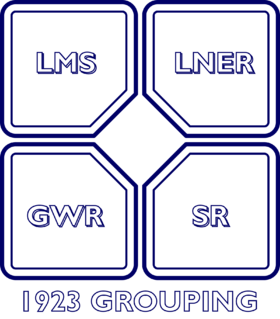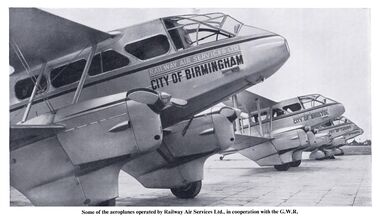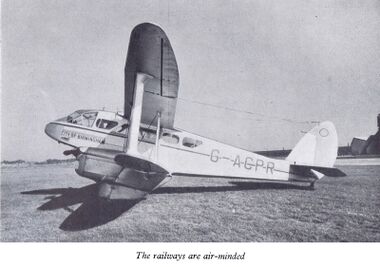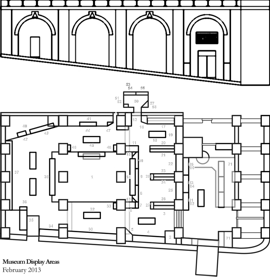Category:The "Big Four" railway companies
| The "Big Four" railway companies |
|---|
 |
| Great Western Railway (GWR) |
| London, Midland and Scottish Railway (LMS) |
| London and North Eastern Railway (LNER) |
| Southern Railway (SR) |
~1935: Fleet of Railway Air Services (RAS) aircraft, a joint venture between the Big Four and Imperial Airways [image info]
City of Birmingham biplane [image info]
The British Big Four railway companies came into existence on 1st January 1923 as a result of the The Railways Act 1921, and continued until a further grouping in 1947 that amalgamated all four to create British Railways.
The long run-up to 1923
Although suggestions for amalgamating Britain's railways had been in circulation since at least as long ago as around ~1850, the political climate made it difficult to argue for cooperation rather than competition. Pure commercial necessity ended up causing most of the reailway systems to merge anyway without government intervention, radically reducing the number of independent companies.
Things changed with the effective governement takeover of the railways during World War One.
From the early days of railways up to 1914, it is estimated that over 1,000 railway companies had disappeared, chiefly by consolidation. Many of these, of course, represented several successive stages of amalgamation. By 1875, the number of separate companies had been reduced to about 247, and the Railways Act of 1921 deals with only 120, although of course various joint lines and a number of light railways were left outside its scope. In 1914, however, there were but 14 "Great" railways in Great Britain, while the Act itself only recognises 25 "constituent" companies (counting the South Eastern & Chatham as one), and several of these, such as the Bany, Cardiff, and Hull & Barnsley, were of purely local importance. Moreover, among all these companies, many forms of working agreement or other co-operative arrangement already subsisted.
... At midnight on August 4th, 1914, the railways were taken over by the Government under the provisions of the Regulation of the Forces Act, 1871. The official announcement made by the War Office stated that: "An Order in Council has been made under Section 16 of the Regulation of the Forces Act, 1871, declaring that it is expedient that the Government should have control over the railroads in Great Britain. This control will be exercised through an Executive Committee composed of General Managers of railways which has been formed for some time, and has prepared plans with a view to facilitating the working of these provisions of the Act."
Simultaneously, a letter was sent by the War Office to a number of individual companies informing them that their railway, including any railway worked by them, was taken over, and directing them to carry on as usual subject to the instructions of the Railway Executive Committee.
The actual control over the railways during the war was thus exercised on behalf of the Government by the Railway Executive Committee, acting under the nominal chairmanship of the President of the Board of Trade …
About this time, the question arose as to whether there should be an extension after the war of the period of control, especially during demobilization and resettlement, and the Government decided that control *should be continued, on the basis of the guarantee of net receipts, for two years after the conclusion of hostilities". Owing to the limitations of the Act of 1871, however, it was apparent that any such extension would require fresh legislation.
In November, 1917, a Railway Advisory Panel was appointed by the President of the Board of Trade to advise him from time to time on questions affecting the future of the railways. Upon this subject, considerable discussion took place during this period audit became manifest that, in view of the changes which had resulted from the war, especially in the economic basis of the railway industry, it would be impossible for the railways to revert to pre-war conditions.
In August, 1918, the Government resolved to give further consideration to the problems of transport after the war, and to this end it appointed a Select Committee " for the purpose of considering what steps, if any, it is desirable to take to develop and improve the internal facilities for transport within the United Kingdom, to secure effective supervision and co-ordination, and to ensure that such developments and improvements shall be adequate and suitable to meet the national requirements."
Early in the next Parliamentary Session, on February 26, 1919, a Bill was brought in by the Government to establish a “Ministry of Ways and Communications. The Bill was placed in charge of the Minister-Designate, Sir Eric Geddes, formerly deputy general manager of the North Eastern Railway, who during the war, after assisting in organising the supply of munitions, became successively Director General of Movements and Railways, Inspector-General of Transportation, and First Lord of the Admiralty. The designation of the new department was subsequently altered to the Ministry of Transport …
... the possession and control of the railways taken over by the Government under the Regulation of the Forces Act, 1871, were retained in the Ministry of Transport for a further term of two years from the passing of the Act, under the same financial guarantees, with a view to affording time for the consideration and formulation of the policy to be pursued by the Government in regard to the future of the railways.
At the end of June, 1920, after an important debate in Parliament, the Ministry issued a White Paper containing an "Outline of Proposals as to the future Organisation of Transport Undertakings in Great Britain and their relations to the State." ... these proposals formed the basis of subsequent negotiations with the railway, trading and labour interests, and eventually were translated, very considerably amended, into the legislative provisions of the Railways Act,
The new transport ministry's plan circa ~1920 was for the Scottish railways to be separate entities. Since the railway system north of the border was not in as strong a position financially as that in England and Wales, it was decided to split the Scottish networks into two and add one part to each of the two companies immediately south of the border, giving the LNER to the East and the LMS to the West.
With the continued integration of London's networks continuing as a separate project (London Transport), the transport networks outside the capital then ended up under the control of just four companies: the "Big Four".
The companies
- Great Western Railway (GWR) already existed, but absorbed additional smaller companies in their territory to the West.
- London and North Eastern Railway (LNER), and
- London, Midland and Scottish Railway (LMS) both had lines running from London through the Midlands and up to Scotland
- Southern Railway (SR) focused on the region to the South of London, stretching down to the South Coast (but with the GWR taking Cornwall and the most westerly section)
The Golden Age
The part of this period up until the outbreak of WW2 in 1939 overlaps with the interwar years that are widely regarded as the Golden Age of British railways, and the Golden Age of steam locomotion in Britain. This was a period after the C19th craze for railway-building had ended, when the resulting system was coming to maturity. The "Big Four" vied against each other to be able to offer the most luxurious services and carriages, the most glamorous locomotives and the most complete integrated transport networks, including hotels, ports, shipping services, and even air transport services.
For model railways, the period coincided with the boom in gauge 0 models and layouts, and included the introduction of the newer and more affordable 00-gauge. With four different major locomotive companies (with their own liveries) each producing their own distinctive "star" locos and replacing them with bigger and better versions every few years, railway travellers and modellers were treated to a constant stream of new and exciting developments until development reached a crescendo in the 1930s, with some new landmark – a new locomotive, speed record or service – appearing practically every year. With the further consolidation of the London Underground system and advent of new luxury streamlined steam trains in the mid-to-late 1930s, it must have seemed that continued progress in public transport in the UK was unstoppable.
The variety of designs and colours, and the continuity of design styles within each of the Big Four in a way that related to their individual heritages meant that it was easy for the public to become emotionally attached to their favourite locomotive or railway service, capturing people's imaginations in ways that the subsequent British Rail never quite managed.
Grouping and Renumbering
Since the different railway companies had had their own independent numbering schemes, their merging required a reorganisation and renumbering to avoid duplicate numbers.
DO YOU KNOW THE NEW LOCOMOTIVE NUMBERS?
EVERY boy and girl who is at all "keen " on railways and railway matters is aware that now the principal railways have been united as "Groups" a great process of renumbering and repainting has been going on, so that it is sometimes difficult to recognize old friends, even on lines we know quite well. The following details should help you to identify the various locomotives and trains you see in your travels and to know to what lines they formerly belonged.
LONDON MIDLAND AND SCOTTISH RAILWAY
- Nos. 1-4999. – These are former Midland locomotives. With them are included engines that were once North Staffordshire, and a few others.
- 5000-9999. – Former London and North Western locomotives. With them are associated engines belonging to the Wirral and other lines.
- 10000-13000. – Late Lancashire and Yorkshire Railway and Furness locomotives.
- 13001 upwards. – Scottish locomotives.
All passenger engines and passenger vehicles on this great system are or will be painted red in the old Midland style.
Goods engines are painted black.
LONDON AND NORTH EASTERN RAILWAY
- Nos. 1 to 2500. – Former North Eastern locomotives. 2501-3000. New locomotives built for the L.N.E.R.
- 3001-5000. – Great Northern locomotives; all these have 3000 -added to their old numbers.
- 5001-7000. – Great Central locomotives; all these have 5000 added to old numbers. Former Great North of Scotland Railway locomotives are numbered with the Great Central series.
- 7001-9000. – Great Eastern locomotives; all these have 7000 added to their old numbers.
- 9000 upwards. – North British locomotives; all these have 9000 added to their old numbers.
All express passenger engines are or will be painted Great Northern green.
Goods and tank engines are painted black.
Passenger carriages are of varnished teak, in the old Great Northern style.
GREAT WESTERN RAILWAY
Locomotives taken over from other railways are numbered as convenient according to class with those of the original Great Western Railway.
The colours of engines and vehicles remain in the old Great Western style.
SOUTHERN RAILWAY
On this system the numbers of the three former railways are retained, but letters are prefixed as follows:
- E (from Eastleigh) – added to numbers of London and South Western engines and coaches.
- A (from Ashford) – added to numbers of South Eastern and Chatham engines and coaches.
- B (from Brighton) – added to numbers of London Brighton and South Coast engines and coaches.
- Isle of Wight locomotives bear the letter W.
Engines and passenger vehicles on this system are now all painted green.
— , -, , The Wonder Book of Railways, , ~1925
1923 London terminus stations
1923 Grouping, London Termini – Zoomable map
KEY: ○ GWR: Purple ○ LMS: Brown ○ LNER: Green ○ SR: Black ○ LMS+LNER: Blue
SR:
- Victoria
- Waterloo
- Charing Cross Station
- Blackfriars
- Cannon Street
- London Bridge Station
GWR:
- Padddington
LNER:
- Marylebone
- Kings Cross
- Liverpool Street Station
LMS:
- Euston
- St Pancras
- Broad Street
- Fenchurch Street
After the Big Four were amalgamated to create British Rail, the existence of a cluster of disparate London terminii linking Central London to the rest of the country, but not obviously connected to each other (except by bus and tube services) was considered an obvious problem, but was not obviousy solvable with the termini owned by four different companies. Tis meant that, rather than being a prestigious stopping-off-point for passenger and freight sevices linking theNorth with the South Coast and Europe, London represented an obstacle that railservices had to skirt around.
Twentieth Century connectivity upgrades
A North-South tunnel linking Kings Cross with Blackfriars (the Snow Hill Tunnel) was reopened and incorporated into the Thameslink project, that now runs trains from north of London, under Central London, to the South Coast, via St. Pancras, Farringdon, Blackfriars and London Bridge stations. St Pancras International Station (north of the river) is the terminus of Eurostar services that connect via part of the North London Line.
Twenty-First Century connectivity upgrades
Paddington (to the west) was eventually linked to Liverpool Street (to the East) by Crossrail's deep underground tunnel in May 2022 (when the link and its additional services ot the west and East were rebranded as the Elizabeth Line).
External links
- Railway Amalgamation In Great Britain, by W. E. Simnett, 1923 (archive.org)
- Big Four (British railway companies) (wikipedia.org)
railways act 1921
Subcategories
This category has the following 5 subcategories, out of 5 total.
G
L
S
T
Pages in category ‘The "Big Four" railway companies’
The following 4 pages are in this category, out of 4 total.
Media in category ‘The "Big Four" railway companies’
The following 3 files are in this category, out of 3 total.
- Big Four logo.png 1,600 × 1,822; 158 KB
- Railway Air Services biplane, City of Birmingham (BRIPAW 1944).jpg 1,600 × 1,124; 556 KB
- Railway Air Services Ltd, City of Birmingham, GWR (GWP 1935).jpg 2,500 × 1,445; 778 KB







